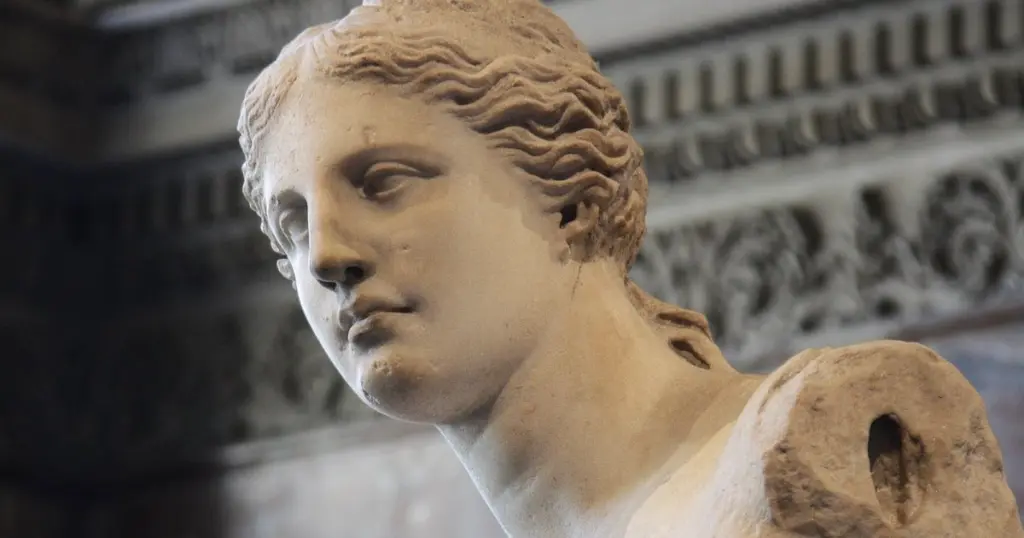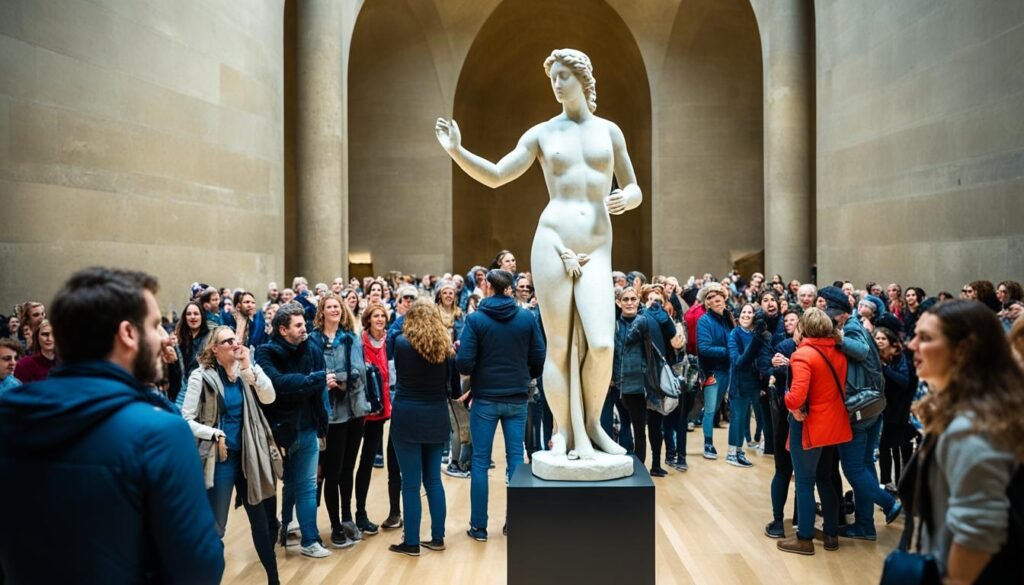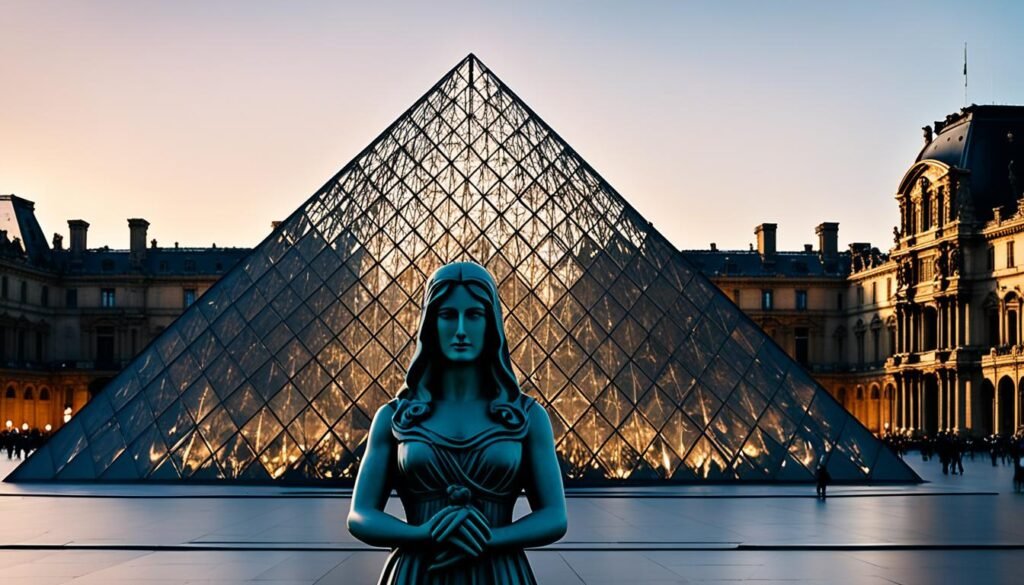Table of Contents
Travel to the world of ancient Greek art to explore the Venus de Milo. This famous work is in the Louvre Museum, in Paris. It grabs the attention of people worldwide. But, what makes this armless sculpture so intriguing?
The Enigma of the Missing Arms

One intriguing part of the Venus de Milo is her missing arms. This mystery has caught the attention of art fans and experts. They’ve come up with many ideas about what the statue might have originally held.
Unraveling the Theories
Experts have come up with different theories about why Venus de Milo’s arms are missing. They suggest what these arms could have carried. This makes the statue even more interesting and meaningful.
- Mirror: The Venus de Milo may have been holding a mirror. This would stand for her divine beauty.
- Apple: Another thought is that she held an apple. This refers to the apple of discord from the Trojan War.
- Laurel wreaths: Laurel wreaths were a sign of success. It’s possible she held laurels to show she was the goddess of love and beauty.
- Shield used as a mirror: A unique theory is she might have held a shield. It acted like a mirror. This would show her beauty and protective nature.
These ideas sound good, but we still don’t know for sure. The statue’s missing arms make people wonder. They ask questions about what she meant and what she was for.
Insert the following table after the paragraph above:
| Object | Symbolism |
|---|---|
| Mirror | Divine beauty and intangible qualities |
| Apple | Golden apple of discord |
| Laurel wreaths | Victory and status as the goddess of love and beauty |
| Shield used as a mirror | Beauty and protection |
Looking at these ideas helps us understand the Venus de Milo better. It shows us the mystery and charm of the statue’s original look.
An Image That Inspires Wonder
The mystery of the Venus de Milo and her missing arms is captured in this image:
The Spinning Venus Theory
One idea about the Venus de Milo is that she was spinning thread. The ancients linked this act to fertility and sex in Greece. They think the statue showed Venus in a divine role in nature.
Today, technology like 3D digital scanning and printing helps us check this theory. Experts have made a detailed model. Now we can see how Venus might have looked spinning thread.
The Process of Recreating the Spinning Venus
They started by scanning the Venus de Milo with advanced gear. Every small detail of the sculpture’s surface was captured.
They then created a digital model. This was used to make a physical copy with 3D printing. Now, researchers can get up close and study the statue.
Revealing the Possible Function of the Venus de Milo
By recreating Venus as a spinner, a new view on her meaning was born. This idea says she, as the goddess of love and fertility, was showing her big role in life’s cycles.
The Spinning Venus theory is a novel way to see the Venus de Milo. It shows us the statue might mean more than we first thought. This makes us value its art and symbols even more.
| The Spinning Venus Theory | 3D Digital Scanning and Printing |
|---|---|
| Proposes that Venus de Milo was spinning thread | Utilizes advanced technology for detailed replica creation |
| Suggests symbolic representation of fertility and sex | Enables closer examination of the statue’s surface |
| Explores the possible divine purpose of the statue | Offers a unique perspective on the Venus de Milo |
The Discovery and Acquisition
In 1820, a local farmer on the Island of Melos found the Venus de Milo. It was a magnificent ancient Greek sculpture. This find started a journey that ended with it being added to the Louvre Museum’s collection.
Soon after, the French Navy fought the Turks over the statue’s ownership. This fight was intense because both sides claimed the sculpture. But, France won and took the Venus de Milo.
The Venus de Milo caught the eye of King Louis XVIII. He chose to donate it to the Louvre Museum. Now, this iconic sculpture is at the Louvre, where it dazzles people from all over the globe.

Today, the Venus de Milo is a star at the Louvre Museum. It enchants everyone who sees it. By being at the Louvre, this statue has become even more famous in the world of art.
| Discovery | Acquisition | Louvre Museum |
|---|---|---|
| A local farmer on the Island of Melos | Battle between French Navy and Turks | Donated by King Louis XVIII |
| 1820 | Victory for France | Permanent home for the Venus de Milo |
The Naming of Venus de Milo
This famous statue needed a name that shows how beautiful and important it is. At first, the Louvre’s Director called it Victorious Aphrodite or Venus Victrix. These names linked it to Aphrodite, the Greek goddess of love and beauty. Yet, the name Venus de Milo started to be used more later on. This name shows that the statue was found on Milos Island and still connects it to Aphrodite. Venus de Milo is a simple yet perfect name for this masterpiece.
Names have always been key in understanding and feeling art’s spirit. The name Venus de Milo is now linked with beauty, grace, and mystery. This makes the statue even more special. Whether you call it Victorious Aphrodite or Venus de Milo, its magic remains strong.
Venus de Milo’s Beauty and Idealism
The Venus de Milo stands as a symbol of timeless beauty and the ideal woman. Her lost arms do not reduce her impact. She draws in viewers with her perfect proportions and elegant stance. She is a key figure in ancient Greek art, the peak of what was considered beautiful back then.
This statue’s flawless symmetry and graceful lines bring a feeling of peace and beauty. Everyone who sees her is captivated. The way she is draped in clothes and her calm face show what the Greeks admired in women.
This work of art proves that classical art still captures the heart of people today. Even without arms, the Venus de Milo’s beauty crosses time and culture. She continues to inspire artists with her perfect shape and the never-ending search for beauty.
Comparison of Proportions
| Statue | Height | Measurements |
|---|---|---|
| Venus de Milo | 6 feet 8 inches | Unknown |
| Average Classical Greek Woman | 5 feet 1 inch | Unknown |
| Average Modern Woman | 5 feet 4 inches | 34-26-36 inches |
This table compares Venus de Milo’s figure to that of an average ancient and modern woman. We may not know her exact size, but she clearly reflects an ideal beauty. This beauty varies from the usual sizes of women across time.
The Venus de Milo is still mesmerized with her appeal and beauty. She is an endless inspiration to those who love art, culture, and ancient Greek beauty. This masterpiece is a treasure, symbolizing a search for a beauty that never fades.
Venus de Milo and the Louvre Museum
The Louvre Museum in Paris is full of famous art, including the Venus de Milo. This statue is very special. It attracts people from all over the world with its beauty and interesting past.
When you visit the Louvre, the Venus de Milo is hard to miss. She stands elegantly, showing the beauty of classical art. Her presence makes the Louvre famous for its art and history.

The Louvre is a treasure trove for those who love art and history. The Venus de Milo is a major draw. Its pose and design make it a top choice for many visitors. It’s a symbol of classical beauty.
Venus de Milo: A Timeless Symbol of Beauty
In the Louvre, the Venus de Milo shows eternal beauty. She represents the ideal woman, admired for her perfect shapes. People still love and respect this statue.
A Glimpse into Ancient Greek Culture
The Venus de Milo takes you to ancient Greece. Artists back then loved to show beauty and perfection. This statue shares early Greek culture with us.
Exploring the Louvre’s Vast Collection
The Louvre has much more than the Venus de Milo. It has art from all over the world and history. Anyone who loves art will find something amazing here. This museum is a true gift for art lovers and curious minds.
| Key Highlights | Description |
|---|---|
| Art Exhibits | The Louvre Museum boasts a vast array of art exhibits, encompassing diverse styles and periods. |
| Famous Sculptures | Among its renowned sculptures, the Venus de Milo stands as a masterpiece of classical art. |
| Artistic Heritage | The museum’s commitment to preserving and showcasing artistic heritage is evident throughout its vast collection. |
Seeing the Louvre is an amazing adventure. It lets you see art through the ages. The Venus de Milo and all its galleries open a door to the past. They show us the incredible power of art.
Sculptors Inspired by Venus de Milo
The Venus de Milo’s beauty and mystery have fascinated us for ages. This statue has inspired artists through the years, including Paul Cezanne and Salvador Dali.
Paul Cezanne was a key player in shaping modern art. He was inspired by the Venus de Milo’s timeless grace. In his art, Cezanne tried to capture her mystique and beauty. His paintings are loved worldwide, partly because of the spirit of this iconic figure.
Salvador Dali was known for his surreal, dreamlike art. He, too, found inspiration in the Venus de Milo. Dali used her mystery in his works to explore the strange, dreamy side of life and art. This made his art truly unique.
These artists show how Venus de Milo has deeply influenced art. Their works, touched by this ancient statue, showcase its enduring power. By inspiring artists of all ages, the Venus de Milo keeps pushing the limits of creativity.
Artists Inspired by the Venus de Milo
| Artist | Influence |
|---|---|
| Paul Cezanne | Captured the timeless beauty and mystery of the Venus de Milo in his paintings. |
| Salvador Dali | Explored the surreal and subconscious elements of the Venus de Milo in his works. |
Unveiling the Secrets of Venus de Milo
Over time, the Venus de Milo has intrigued many. Scholars, researchers, and art fans have worked hard on it. They aim to reveal its secrets, for it is an ancient Greek sculpture full of mysteries.
The Venus de Milo’s creation might have used tricks to seem older and more beautiful. Some say it could be made to seem old on purpose. This makes us understand its full importance and the artist’s thoughts better.
The missing arms of the Venus de Milo are notable. Many wonder what they originally held. The guesses range from a mirror to a protective shield. Exploring these ideas shows us the sculptor’s deep thought and the statue’s possible messages.
Experts found small, hidden details in the Venus de Milo. These reveal the sculptor’s mind and the times it was made in. Even the way her clothes flow and how her body is positioned adds to the story.
Discovering these secrets helps us see the Venus de Milo in new ways. It improves our knowledge of ancient Greek art and culture. The secrets also show the sculptor’s cleverness and push us to rethink art.
The Artistic Deception Behind Venus de Milo
| Artistic Technique | Description |
|---|---|
| Artificial Aging | The deliberate addition of patina and weathered effects to create the illusion of age and authenticity. |
| Intentional Imperfections | The purposeful inclusion of minor flaws and irregularities to lend an air of authenticity and human touch. |
| Subtle Alterations | The careful manipulation of proportions and features to evoke specific emotions and convey deeper meanings. |
The Venus de Milo persists as a symbol of art’s hidden depths. As we learn more, we value its power to intrigue and inspire. Truly, the sculptor’s craft and the artwork challenge our perceptions, engaging us deeply.
The Recognition and Significance of Venus de Milo
The Venus de Milo is a special symbol of beauty and culture. Created between 130 and 100 BCE, this statue still captivates people worldwide.
Her graceful pose and balance show the best of ancient Greek art. She carries a timeless beauty that moves through ages.
More than her looks, Venus de Milo tells us about ancient Greece. She’s in the Louvre, making her even more important in the art world.
Her impact goes beyond just looks. She has inspired countless art pieces and is an icon in culture and literature. Many have used her as a model for their art.
She’s not just any statue; she’s a symbol of beauty and art. The Venus de Milo is an essential piece of historical sculpture.
Venus de Milo’s Cultural Impact
She’s not just a statue; she’s a cultural icon. Found in the 19th century, she now stands as a symbol of history’s artistry.
| Key Points | Cultural Impact |
|---|---|
| 1 | Inspiration for artists |
| 2 | Symbol of beauty and femininity |
| 3 | Representation of ancient Greek civilization |
| 4 | Global recognition and admiration |
Artists like Paul Cezanne and Salvador Dali were inspired by her. They show how she bridges ancient and modern through their works.
She is more than just a beautiful statue. The Venus de Milo shapes fashion and pop culture. Her image is everywhere, connecting modern life to ancient art.
She also offers insight into ancient Greece. Through her, we learn about their gods, art, and ideals.
She’s revered globally at the Louvre. Venus de Milo stands as a testament to lasting artistic brilliance.
Venus de Milo Replicas and Variations
The timeless beauty and classic Greek style of the Venus de Milo have inspired the creation of numerous replicas and variations. These reproductions let art lovers bring a piece of ancient art into their homes or exhibit spaces. They capture the elegance and allure of the original sculpture.
Artists recreate the Venus de Milo’s intricate details. They make sure every curve and contour is true to the classic Greek style. These replicas are crafted with care, using high-quality materials and techniques to capture the original’s essence.
If you love ancient art or the timeless beauty of the Venus de Milo, owning a replica brings the masterpiece to life. Whether in your living room, study, or gallery, its presence will captivate and inspire everyone who sees it.
Venus de Milo replicas come in various sizes and materials. This allows you to pick what fits your space and taste. You can choose from small tabletop versions to life-sized replicas.
For more authenticity, some replicas come with pedestals or display plinths. This adds the feel of a museum or art gallery setting. These extras underscore the Venus de Milo’s importance and grandeur.
Make your space beautiful with a Venus de Milo replica that captures the original’s essence. Whether for your art collection, love of history, or admiration for ancient art, a Venus de Milo reproduction is perfect. It will be a key piece in your home or exhibition.
The Fascination with Venus de Milo
The Venus de Milo is well-loved because of its mysteries. The missing arms spark interest, along with her beauty. The stories about how she was made and found also add to her mystery.
Art lovers and historians cherish ancient art. The Venus de Milo shows timeless grace with its detailed design. It draws viewers into its beauty and mysteries from long ago.
This statue shows more than just an ancient figure. It reflects Greece’s rich past and its art achievements. When people look at it, they connect with a world of artistic and cultural wonders.
People are still fascinated by the Venus de Milo for many reasons. Her missing arms and the talent of her creators interest us. This sculpture serves as a gateway to olden times, captivating us with its beauty and history.




